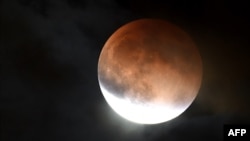Sky gazers have a special treat to look for later this month when a “supermoon” lights up the heavens.
According to NASA, the November 14th full moon will be the closest full moon of this year, and the closest to Earth since 1948. It won’t be as close again until November 25, 2034.
Even if the skies are cloudy on the 14th, the moon will still be very bright on the nights leading up to the supermoon.
A supermoon is when the moon and Earth are closer than they usually are, if only by a small margin. The slight change, however, can cause the moon to appear up to 14 percent larger and 30 percent brighter than a normal full moon.
The term supermoon is relatively new, having been created in 1979 by astrologer Richard Nolle.
Others have referred to the supermoon as a “mega beaver moon.” That name comes from the Old Farmer’s Almanac, which said it got that name because “for both the colonists and the Algonquin tribes, this was the time to set beaver traps before the swamps froze, to ensure a supply of warm winter furs.”
And if you miss the November supermoon, fret not. There will be another one on December 14. The bad news about that supermoon, according to NASA, is that it will drown on the view of the Geminid meteor shower.









